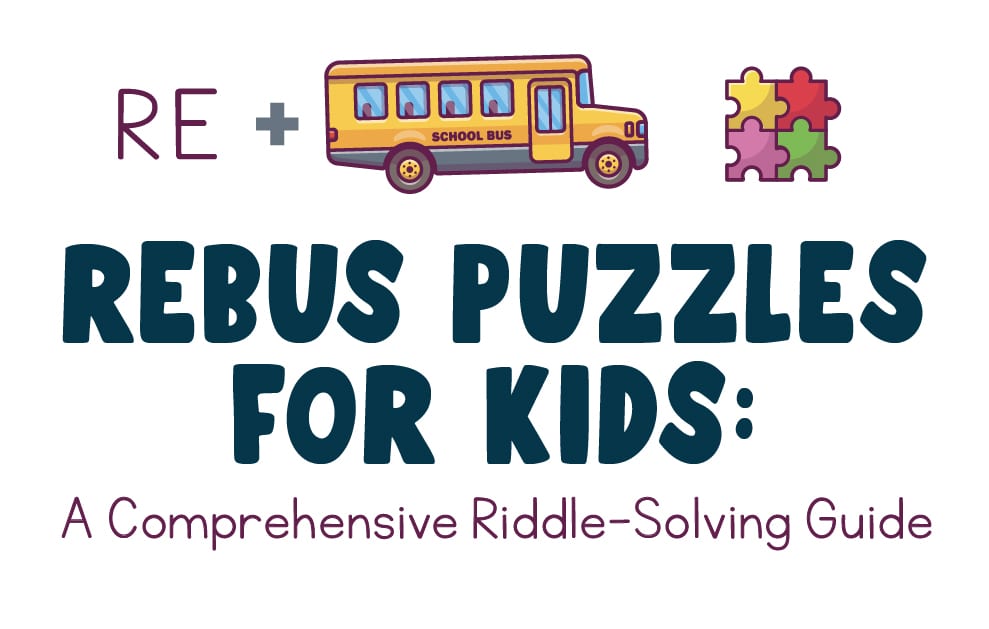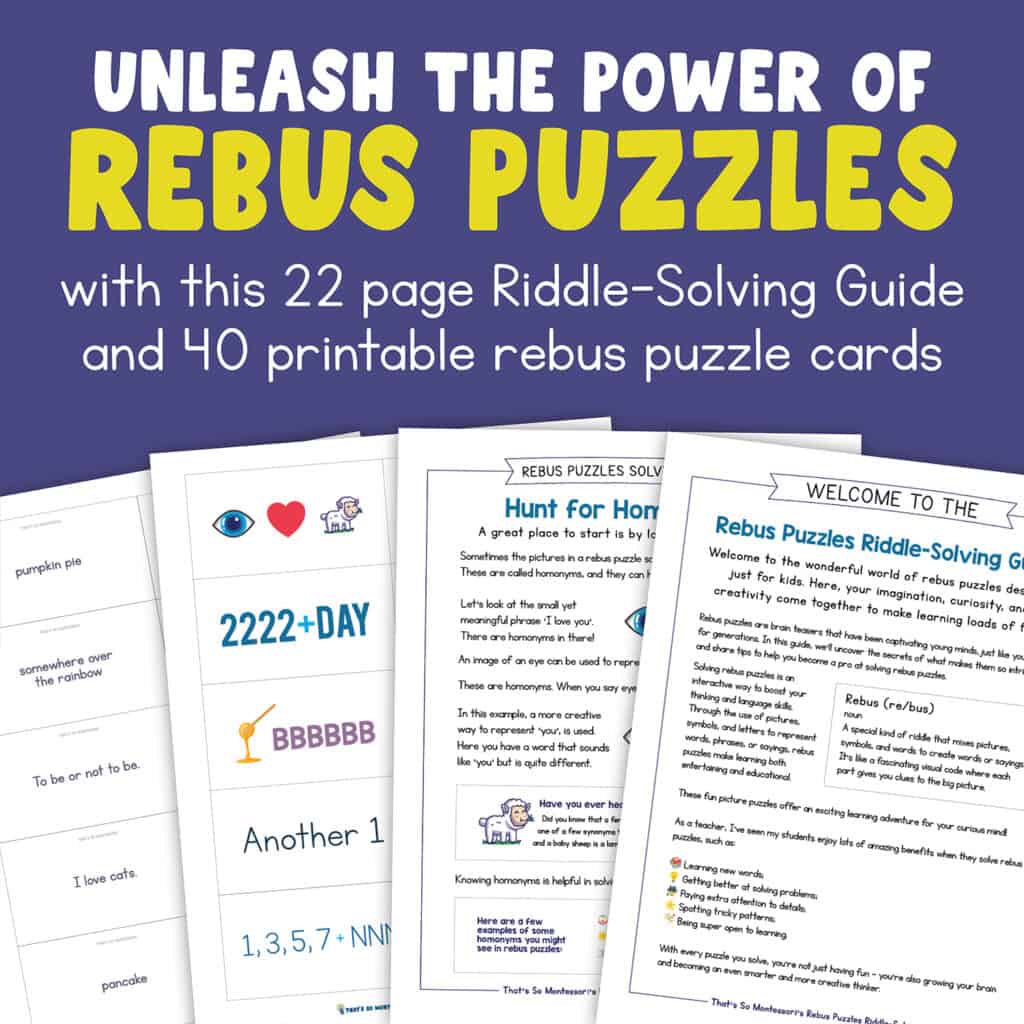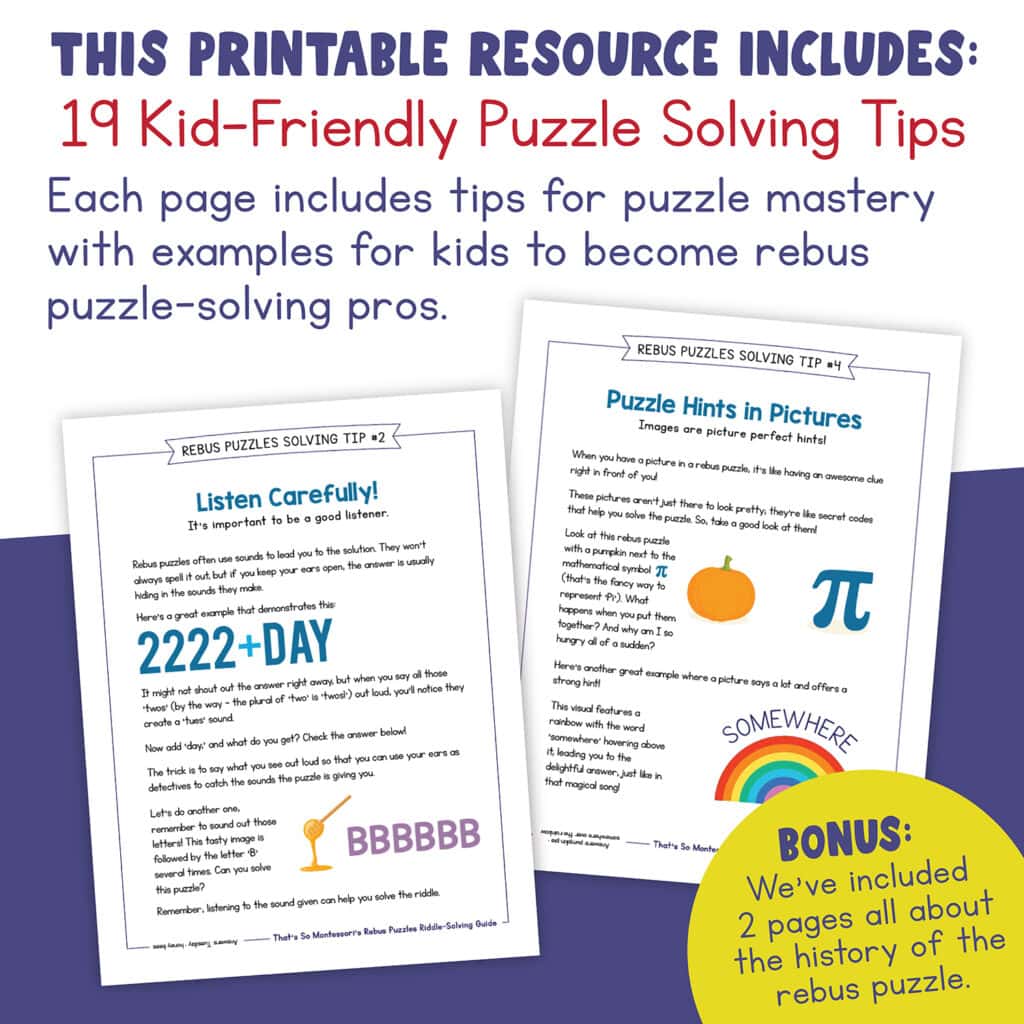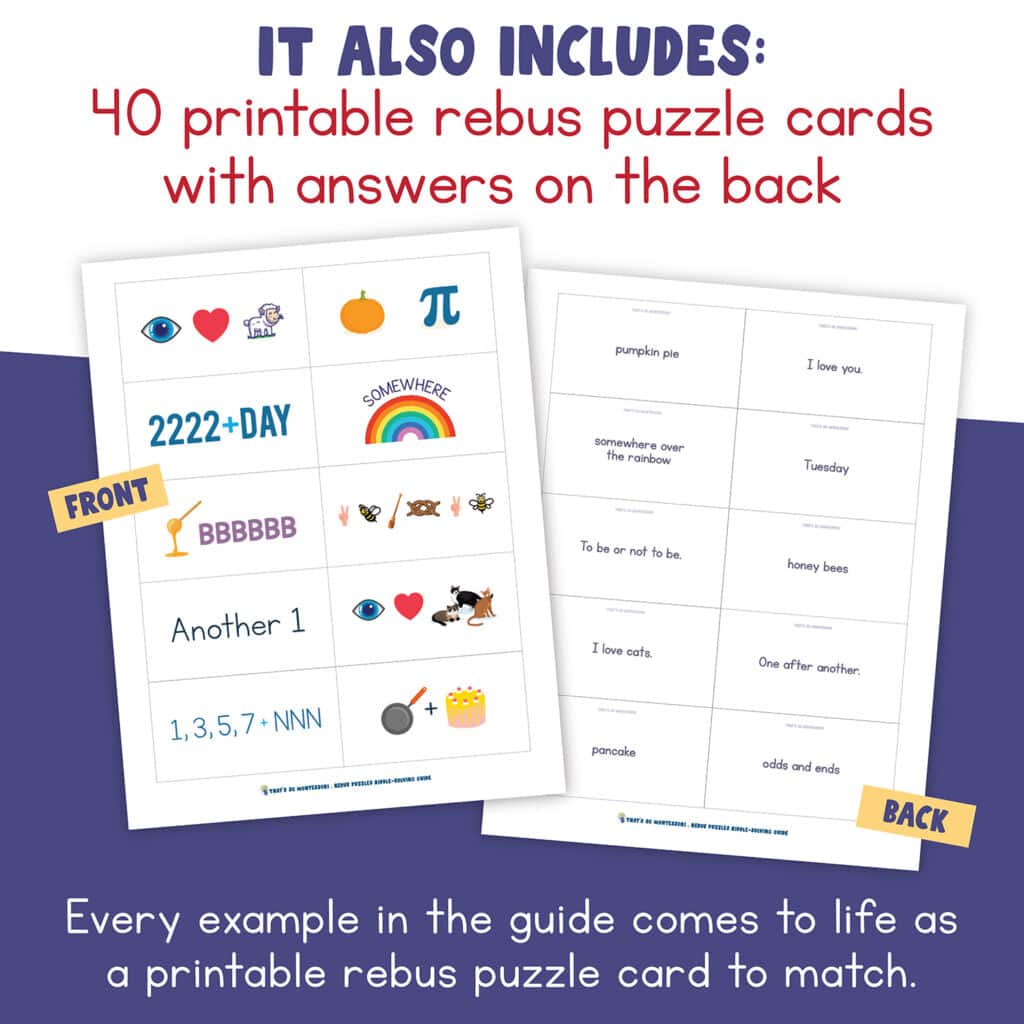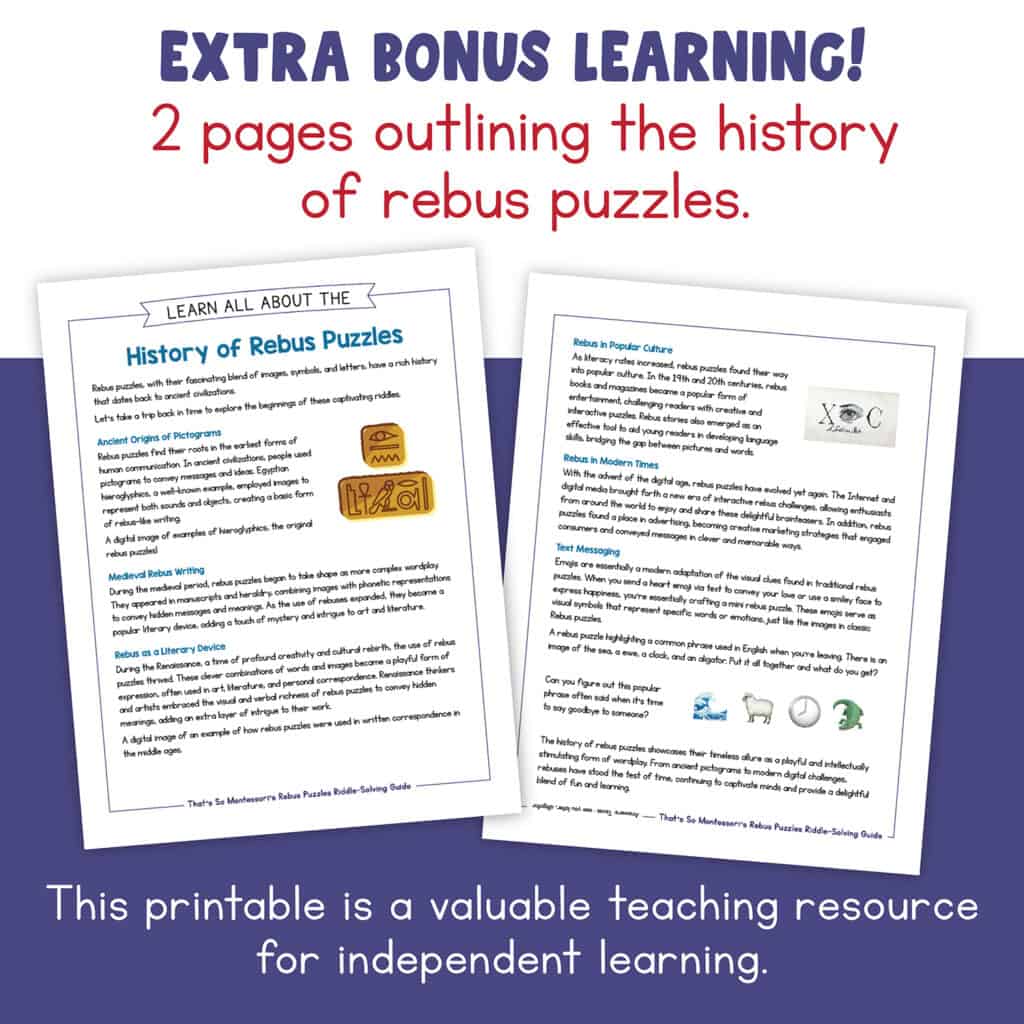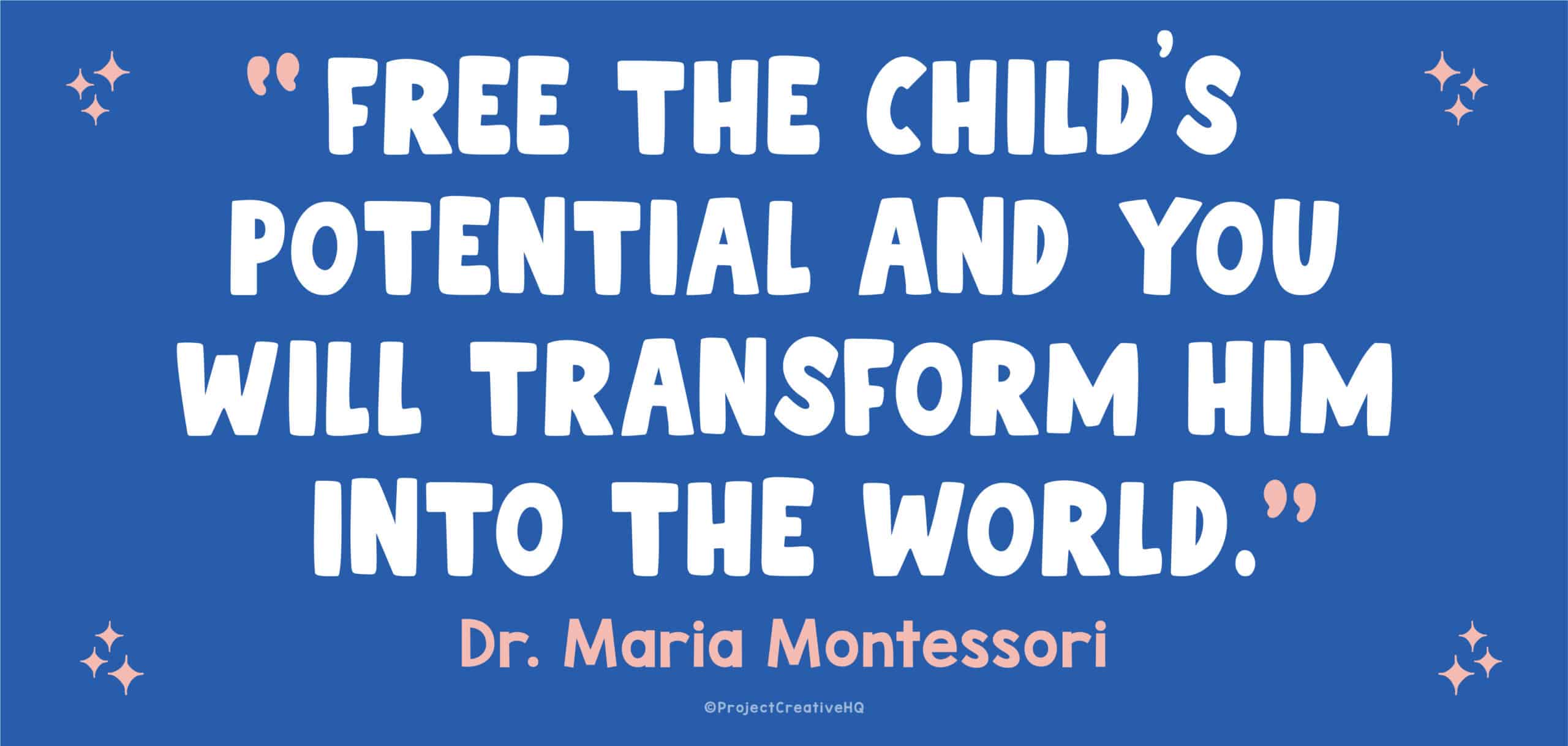Rebus Puzzles for Kids: A Comprehensive Riddle-Solving Guide
As an experienced elementary teacher dedicated to igniting young minds, I’m excited to tell you all about rebus puzzles for kids.
Rebus puzzles have been a hit with curious elementary students for ages, blending pictures and words for brain-teasing fun. What’s special is how they fit right into the Montessori way! They encourage creativity and problem-solving, just like the hands-on learning in Montessori classrooms.
This blog introduces rebus puzzles and shares easy tips to solve them. We’ll talk about how they help with learning words and why both kids and grown-ups love them. Plus, we’ll explore their history and ways to use them in elementary classes.
🧩 Check Out Our Printable Kid-Friendly Rebus Puzzle Guide!
After writing this awesome blog, we recognized the value of having this resource in print form, accessible to kids, teachers, learners, educators, and puzzle enthusiasts. Whether it’s for classroom lessons, as handy handouts, or for delightful home fun, this guide is here to make learning and puzzling a breeze.
Have you ever noticed that many of the rebus puzzles out there seem very similar? We certainly have, and that’s what inspired us to create this unique product, featuring a collection of 40 new and improved rebus puzzles for kids!
You can find all our products on Teachers Pay Teachers and Etsy.
Parents, teachers, caregivers, students, and puzzle enthusiasts of the world, join us in this comprehensive look at solving rebus puzzles with kids. Just be ready for a bit of learning in disguise, frequent teachable moments, and lots of fun along the way.
We’re glad you’re here for this brain boosting experience!
What Are Rebus Puzzles for Kids?
Rebus puzzles for kids are a captivating and interactive way to promote critical thinking and language skills.
These puzzles use a blend of images, symbols, and letters to represent words, phrases, or sayings, making learning both fun and educational.
🧩 Rebus (re/bus)
noun
A representation of words or syllables by pictures, letters, numbers, symbols, and geometric figures whose names resemble and come together to create the intended words or syllables in sound.
Instead of using traditional written words, these puzzles use visual clues to convey meaning. Each element in a rebus puzzle contributes to the overall message, creating a fun and interactive challenge for the solver.
For example, a rebus puzzle may use an image of an eye to represent the word ‘I’, a heart shape to symbolize ‘love,’ and the letter ‘u’ to stand for ‘you.’ When put together, ‘I love you’ is what this rebus puzzle represents. Cute!

These brain teasers are not only entertaining for kids but also beneficial for cognitive development.
I love using them with my elementary students to foster language skills, creativity, and critical thinking. With their captivating charm, rebus puzzles provide a wonderful way to ignite young imaginations through the power of word and image combinations.
Did you know?
The origin of the term “rebus” traces back to the Latin phrase “non verbis, sed rebus,” translating to “not by words, but by things.”
🧩
This insightful phrase highlights the essence of rebus puzzles, where images, symbols, and letters convey meaning beyond written words.
🧩
Learn more about the history of the rebus puzzle here.
Stay tuned for our upcoming rebus puzzle sets and enriching blog posts, thoughtfully designed to enhance your child’s learning journey. Be the first to know about these exciting new releases by joining our mailing list!
Elevate education and play with our rebus puzzle products today and make learning a puzzle worth solving.
19 Strategies to Solve Rebus Puzzles for Kids
Elementary students can become rebus puzzle masters with these strategies!
Check out our expert tips and tricks to help elementary learners solve brain teasers with confidence. These insights, ranging from decoding visual clues to unraveling hidden messages, will not only enhance puzzle-solving skills but also ensure that the entire experience becomes even more enjoyable for everyone!
1. Hunt for Homonyms
Sometimes the pictures in a rebus puzzle sound like more than one word! These are called homonyms, and they can help you solve the puzzle.
If we continue with the example of ‘I love you’, you can find two homonyms in that small yet meaningful phrase. An image of an eye can be used to represent ‘I’ while an image of an adorable ewe can be used to represent ‘you.’ Knowing homonyms is helpful in solving this type of puzzle.
Even if children are unfamiliar with the term ‘ewe,’ this presents an excellent opportunity for a teachable moment. They can explore the concept of homonyms, and discover synonyms for ‘lamb’ and ‘sheep’ in a thesaurus, ultimately expanding their vocabulary, and potentially leading them to the word ‘ewe.’

Here are a few examples of some homonyms you might find in rebus puzzles:
🐎 horse and hoarse
☀️ sun and son
👂 hear and here
2️⃣ two and too
☮️ peace and piece
🐑 Never heard of a ewe?
A ewe is a female sheep! A male sheep is a ram, a baby sheep is a lamb, and a group of sheep is called a flock.
If you find that interesting, then you will love our Noun Memory Matching Game, a multilayered activity that grows with your child!
This 120-card matching game offers beautiful, clean, crisp imagery with 20 different animals that will take your Language and Biology lessons to the next level.
2. Listen Up!
Rebus puzzles love to play with sounds to lead you to the solution. They may not spell it out for you, but the answer often hides within the sounds they make.
Here’s a great example that demonstrates this:

It might not shout out the answer right away, but if you say all those ‘twos’ (Fun Fact – the plural of two is twos!) out loud, you’ll notice they create a ‘tues’ sound. Add ‘day,’ and what do you get?
Let’s look at another example.

Here you see an image followed by the letter ‘B’ written several times. What sound do all those letters make together? That will help you solve this buzzing riddle!
The trick is to get students to say what they see out loud so that they can use their ears as detectives and pay attention to the sounds the puzzle is giving off.
Answers:
Tuesday
honey bees
3. Numbers as Puzzle Pieces
When you spot numbers in a rebus puzzle, it’s time to put on your detective hat!
You’ll want to count the numbers, look for patterns or sounds they make, note if they are even or odd, and even look closely at their location in the puzzle.
For example, in this puzzle, the location of the number 1 is key to coming up with the answer. Can you solve it? The answer to this one can be found at the end of this section.

Let’s try another example using numbers:

In this example, knowing that these numbers are odd and keeping tip #2 about listening in mind is helpful in solving the riddle.
Whenever you come across numbers in a rebus puzzle, think of them as your little helpers, ready to team up with you to crack the code and unveil the puzzle’s secrets!
Answers:
one after another
odds and ends
4. Picture Perfect Clues
When you have a picture in a rebus puzzle, that’s like having a super hint right in front of your eyes!
These pictures aren’t just there to look pretty; they’re like secret codes that help you solve the puzzle. So, take a good look at them!
Here we have a picture of a pumpkin next to the mathematical symbol 𝛑 (that’s the fancy way to represent ‘Pi’). What happens when you put them together? And why am I so hungry all of a sudden?
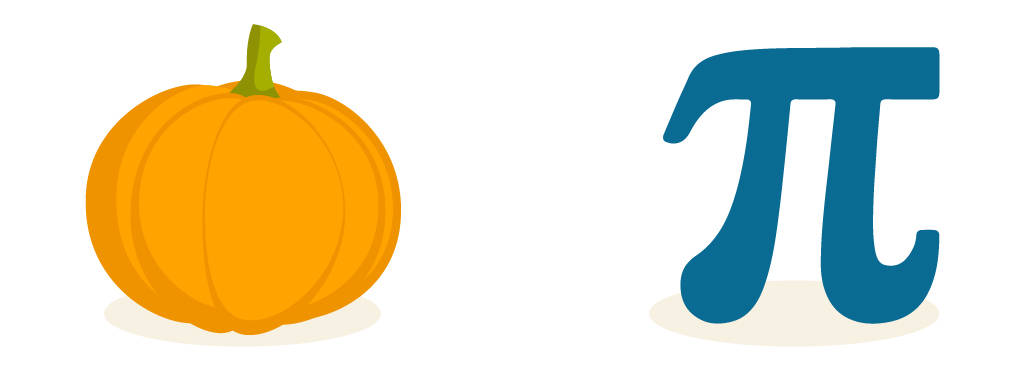
Here’s another classic case where a picture speaks volumes, or in this case, offers a stellar hint! This visual features a rainbow with the word ‘somewhere’ hovering above it, leading you to the delightful answer, just like in that magical song!
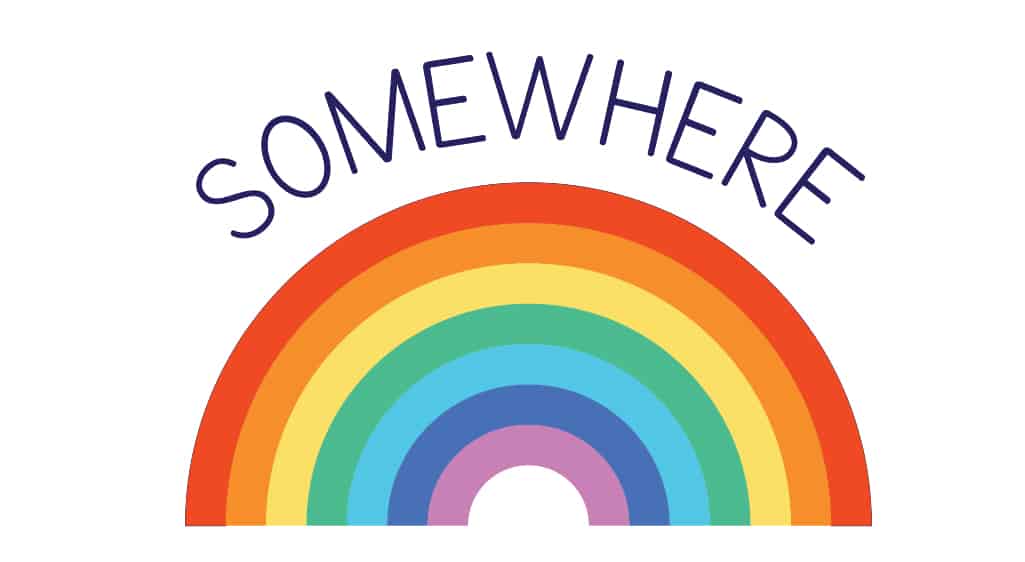
Answers:
pumpkin pie
somewhere over the rainbow
5. Pictures for Each Word in a Phrase
Sometimes, these puzzles get super creative by using an image to represent every single word in a phrase.
Usually, there is a small gap between each image, making it clear that it’s not just a jumble of pictures or one big word. Put your understanding of homonyms and word sounds to the test to solve this example!

In this clever arrangement, we have the number 2, a bee, an oar, a knot, another number 2, and yet another bee. When you piece it all together, you unlock the answer to this rebus puzzle, which is the iconic Shakespearean quote from Hamlet.
Here’s another example where pictures stand for all the words in a sentence. Can you solve this one? The answer to this riddle is a fact about me!

Be sure to keep an eye open for puzzles made entirely of pictures!
Answers:
To be or not to be.
I love cats.
6. Compound Words
Compound words are often used in rebus puzzles.
These words are formed by joining two or more individual words to create a completely new word, and they can be a valuable clue in deciphering the puzzle’s message.
In rebus puzzles, compound words are usually separated by a plus sign (+), indicating that they should be combined into one compound word.
For example, what do you get when you put these two images together? What word can you make? Check below for the answer!
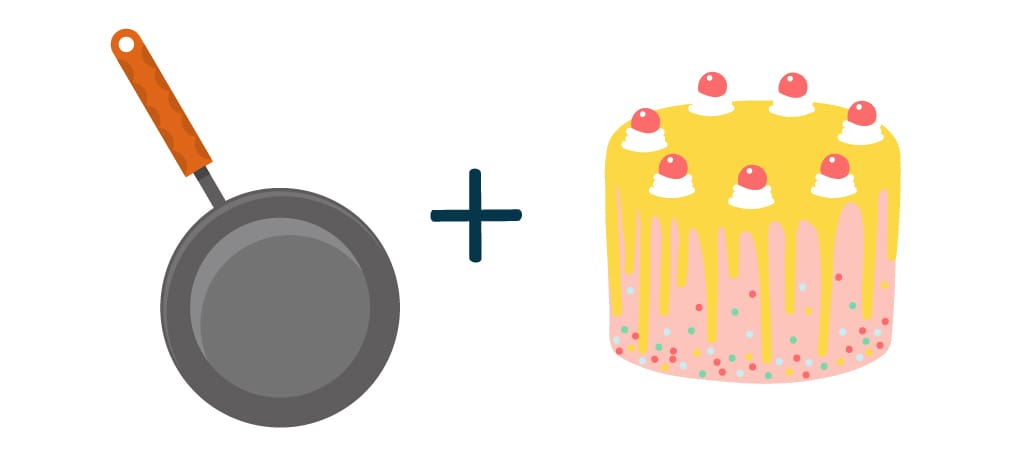
Check out these rebus puzzles that represent common compound words:
🐕 + 🏠 = doghouse
🚪 + 🔔 = doorbell
💪 + 🪑 = armchair
🌧 + 🧥 = raincoat
🗝 + 😑 = keyboard
👂🏼 + 📞📞📞 = earphones
✉️ + 📦 = mailbox
Mastering the concept of compound words not only helps in unraveling rebus puzzles but also nurtures language skills and enriches your overall linguistic comprehension, making the experience of solving these visual conundrums even more rewarding and enjoyable.
Answer:
pancake
7. Adding and Subtracting Letters from Words
You might see the mathematical symbols for addition (+) and subtraction (-) in a rebus puzzle followed by a letter.
This indicates that the letter provided needs to be added to or taken away from the word represented by the picture and that will give you a whole new word.
For instance, consider the rebus puzzle:
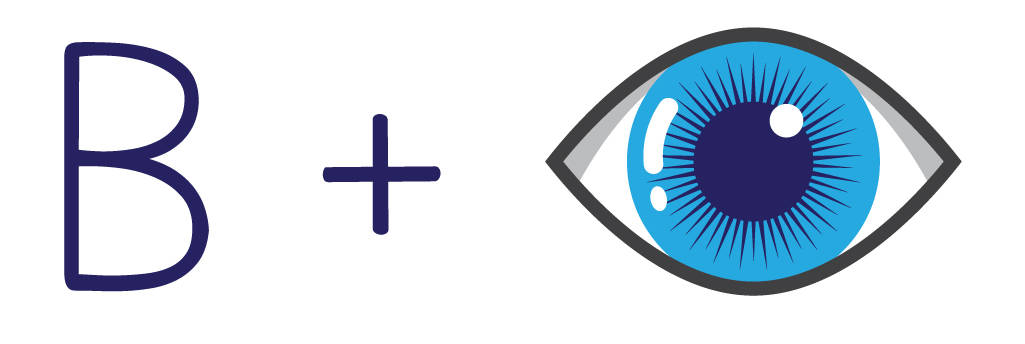
The ‘+’ sign serves as your clue to combine the letter ‘B’ with the image of an eye, resulting in a word often used when you’re saying goodbye to someone or someplace. It could also stand for a word describing how something is done or a term that means making a purchase. Homonyms are pretty awesome, right?
But the fun doesn’t stop there, check out this example:

Rebus puzzles make language learning even more exciting. Plus, they bring a touch of math to the world of words, giving your brain an extra workout.
Answers:
bye/by/buy/bi- (any of these homophones work here!)
flying
😎 Enjoying this blog?
Then you’ll want to get your hands on the printable, kid-friendly version of this blog post. You can purchase it here!
8. The ‘+’ Sign Might Stand for ‘And’
When you see the ‘+’ sign within a rebus, it doesn’t always indicate that addition is required or that you’re dealing with a compound word.
Instead, it’s it can just be a sneaky way of saying ‘and’, as in this example:
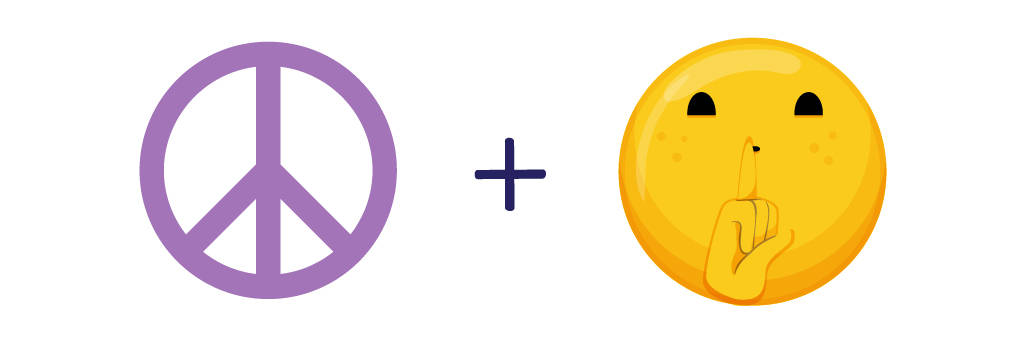
When combined, these images create a phrase that signifies a serene and noise-free environment. Peace and quiet! Something we are all looking for after long days of adulting.
But wait, it’s also important to know that the ampersand symbol (&) also represents ‘and’.
Here’s a great example showcasing the use of the ampersand:
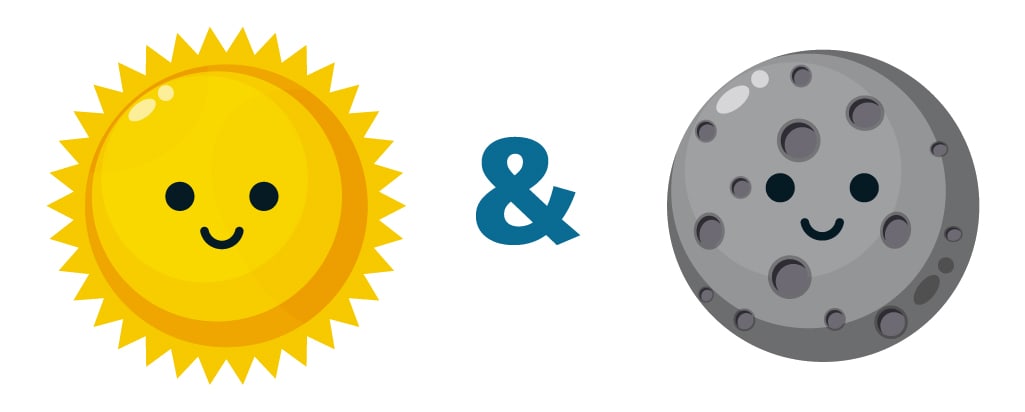
What do these two images represent other than the obvious sun and moon? You can check the answer below!
& The Amazing Ampersand &
The story of the ampersand (&) dates back to ancient Rome. In those days, they didn’t have fancy pens or keyboards like we do. Instead, they used special curly letters and wrote quickly. To save time and make things look pretty, they often joined letters together in a special way, kind of like secret codes.

And guess what? The ampersand started as a special combination of the letters ‘E’ and ‘T.’ In Latin, ‘et’ means ‘and.’ So, every time you see an ampersand, you’re looking at a piece of history from ancient Rome, where writing was an art form! You can read more about it in this article.
Answers:
peace and quiet
day and night
9. Mastering Rebus Puzzles for Kids with Prepositions
Prepositions, one of the eight parts of speech, are those clever words or word groups that tell you where something is in relation to something else.
When solving rebus puzzles kids need to keep the more common prepositions (‘in,’ ‘on,’ ‘under’) in mind, and they should be aware of where words are in the riddle. Prepositions are very telling!
Here are some prepositions shown by an adorable cat:

Let’s uncover the power of location in rebus puzzles with four exciting examples. You’ll find the answers below.
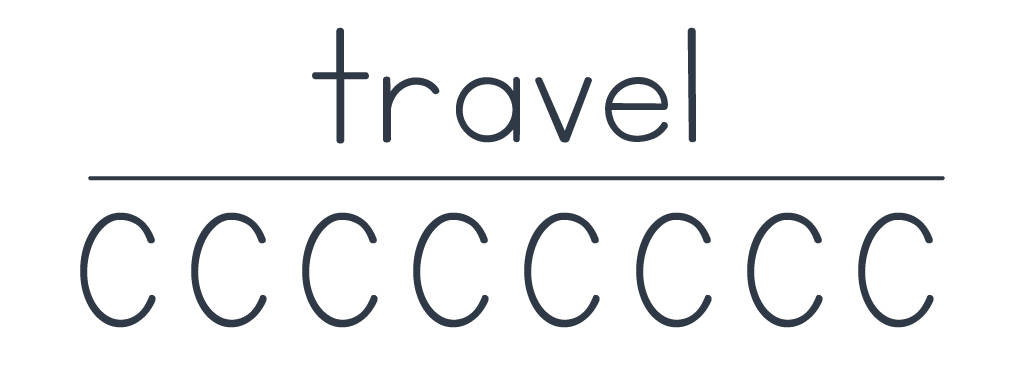

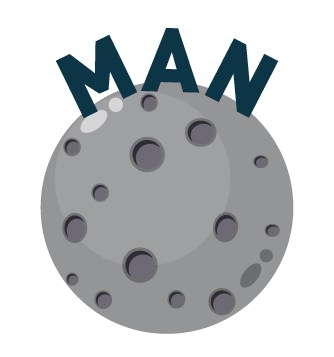

Answers:
travel overseas (ok, ok, so overseas is not a preposition, but, the way it is used to bring about the answer is!)
safety in numbers
man on the moon
in between meals
You can see that understanding prepositions play an important part in becoming a rebus puzzle-solving expert!
✏️ Looking for ideas to supplement your parts of speech lessons?
Check out our parts of speech products for elementary language enrichment. Engage your students with interactive tools and resources that make learning grammar fun and accessible.
Explore our collection today to enhance your teaching and foster a deeper understanding of language fundamentals.
➡️ Looking for something specific? Let us know and if we make it you get it for FREE! Email us at thatssomontessori@gmail.com!
10. Math Symbols in Rebus Puzzles
Rebus puzzles often playfully incorporate math symbols as clever clues.
That’s one of the things I love about rebus puzzles! They really stretch your thinking in a variety of directions and even bridge different subjects. In Montessori philosophy, this approach is referred to as “cosmic education.”
Your students will put their math skills to work, as they encounter puzzles that include numbers, symbols, fractions, and even math signs for addition, subtraction, division, and multiplication.
Now that you’ve seen how the Pi symbol can be used in a rebus puzzle (strategy #4), check out these examples demonstrating how different math symbols are used in rebus puzzles for kids.

You have 12″ in the word DOOR (Yay, prepositions!). Twelve inches (12″) is also known as a foot, and that math knowledge of measurement will lead you to the answer. Can you solve this tricky rebus puzzle example?
Want an even trickier rebus puzzle? Try this one out:

It’s always fun to use the infinite symbol!
Answers:
A foot in the door.
To infinity and beyond.
11. Spot the Missing Piece
When it comes to solving rebus puzzles, keen observation must extend to recognizing what’s missing from familiar patterns, like the alphabet or number sequences.
Keep your eye out for these intriguing gaps! Here’s an example to try:

What’s missing in the alphabet? That says it all!
Here’s another tricky rebus puzzle for kids. Can you solve it?

This is a phrase you may use when reuniting with someone you haven’t seen in a while.
Being a sharp observer (and as a result a top-notch rebus puzzle-solving master) means noticing what’s not there in familiar patterns. This makes these challenges an exciting adventure for the curious mind of the child in the second plane of development.
Answers:
Missing you.
Long time no see.
12. Uncover Idioms
Keep an eye out for symbols and images that come together to form everyday sayings and expressions, which are known as idioms.
Idioms are like secret codes in language. They are special phrases that can’t be understood just by looking at each individual word. Instead, they have unique meanings that are familiar to people who speak that language.
This rebus puzzle for kids is a tricky one! It represents an idiom people say when they think something is impossible or can’t happen.

Here are some common idioms in the English language:
🍰 ‘A piece of cake’ means something is very easy to do.
🥒 ‘Cool as a cucumber’ describes someone who keeps cool in stressful or difficult situations.
🐝 ‘Busy as a bee’ suggests someone is working very hard.
🐈 ‘Who let the cat out of the bag?’ is used when someone accidentally reveals a secret or information that was meant to be kept hidden.
🌎 Idioms exist in all languages!
What makes idioms even more interesting is that different languages have their own set of idioms.
Just like how we say, “Game over!,” in English to express a disastrous situation or the dramatic end of something, other languages have their own colourful phrases. For example, in French, they say, “C’est la fin des haricots,” which translates to “the end of the beans” but is an idiom that means something not so good is about to happen.
Answer:
When pigs fly.
13. Word Arrangement
Keep a sharp eye on how words are arranged – whether they’re written backward, diagonally, descending, or even turned upside down. These are valuable clues to cracking the riddle.
You’ll love this example! The words ‘I fell’ are written many times vertically in the shape of a tower. Can you guess this famous landmark?
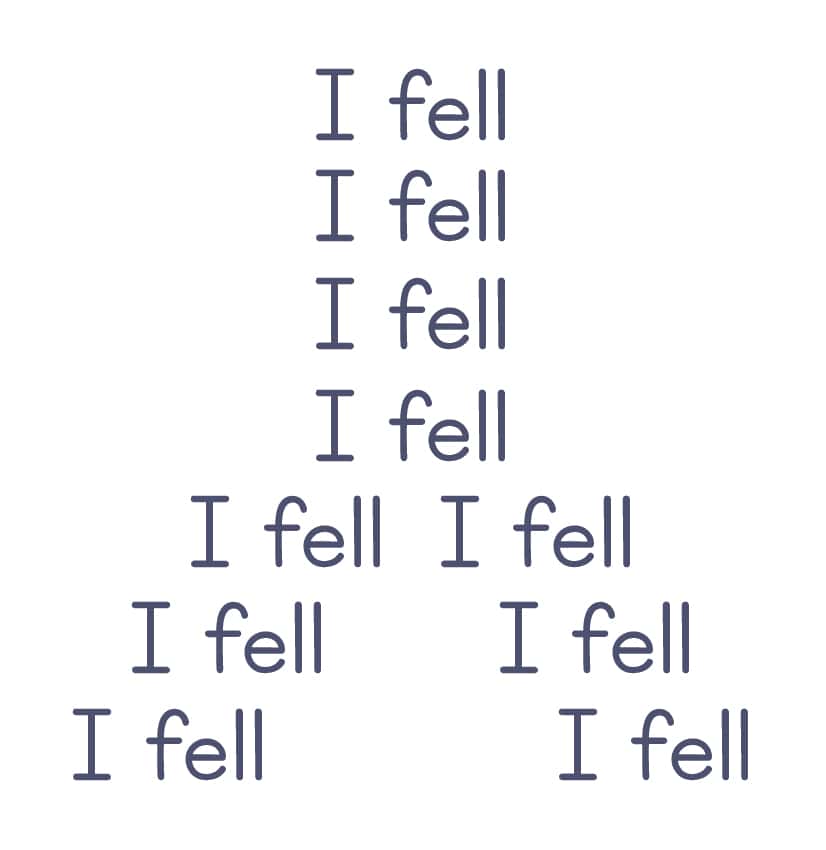
Now here are some words heard by elementary students every morning! This rebus puzzle is another example that demonstrates how word direction can play an important role in creating an epic puzzle.
Here we have the word ‘wake’ written vertically and read from the bottom up. What is this mystery saying?

Answers:
Eiffel Tower
Wake up!
14. The Secret of Texture in Rebus Puzzles for Kids
Sometimes, rebus puzzles use words written in specific textures to give you hints. These tactile details provide deeper insights into the puzzle’s message.
For instance, when you see the word ‘record’ in a font that looks cracked or in pieces, it cleverly suggests that it is broken, leading you to decipher this rebus puzzle answer, which is also an idiom meaning someone keeps saying the same thing over and over again.

This rebus puzzle is as vibrant as a lime! That’s your hint for unraveling this colourful and clever riddle.
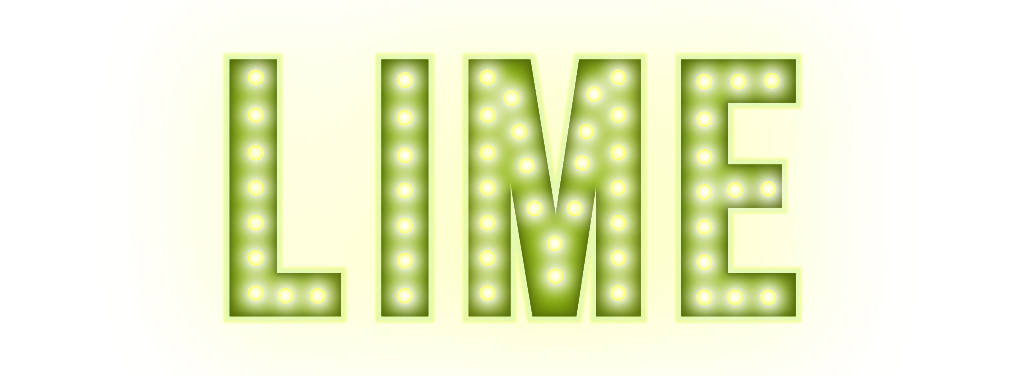
Paying attention to textures can help you solve rebus puzzles with ease.
Answers:
broken record
limelight
15. Broaden Your Vocabulary with Synonyms
In rebus puzzles, it’s essential to be open to alternative words for common images. Essentially, you’re considering synonyms when looking for answers.
For instance, here’s a picture of a cat and a smiley emoji face. Can you guess what phrase these images make?
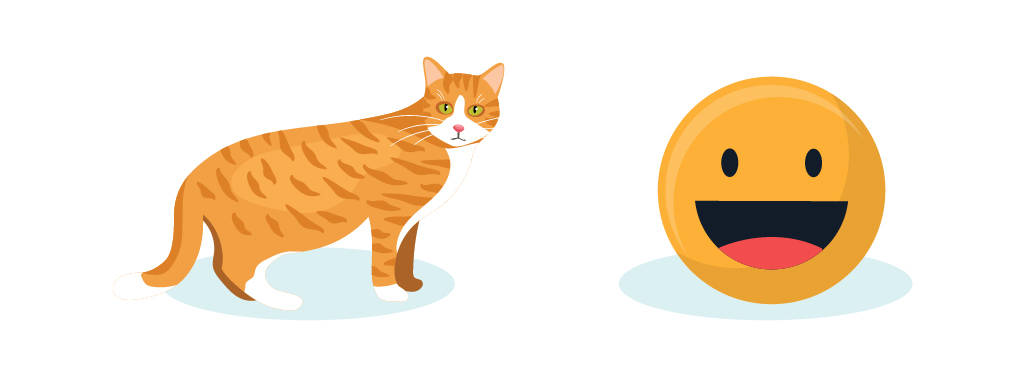
When you see an image of a cat, consider that it could represent the words kitty, kitten, feline, tabby, or even mouser, providing various options for words and sounds.
In this case, what do you suppose the cat represents? Can you solve this picture puzzle?
Now that you know that a female sheep is a ewe, give this example a try!
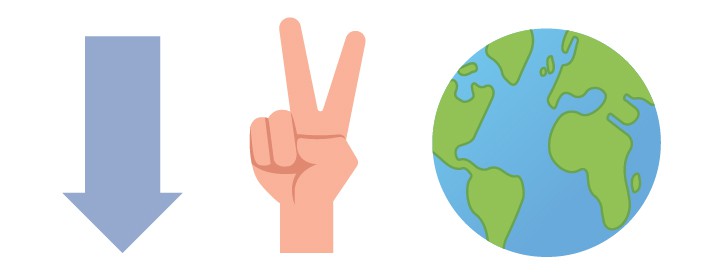
Encourage students to explore synonyms and stretch their vocabulary with rebus puzzles!
Answer:
Feeling (feline) happy.
down to earth
16. Words on Repeat
Don’t overlook the importance of repetition in rebus puzzles.
When a word or image appears multiple times, it’s a significant clue that can lead you to the solution. Count how many times the word is written and keep that in mind as you work to solve the riddle.
Take, for example, the rebus that showcases the word ‘thanks’ written many times – what message does it convey? You can check the answer at the end of this section.
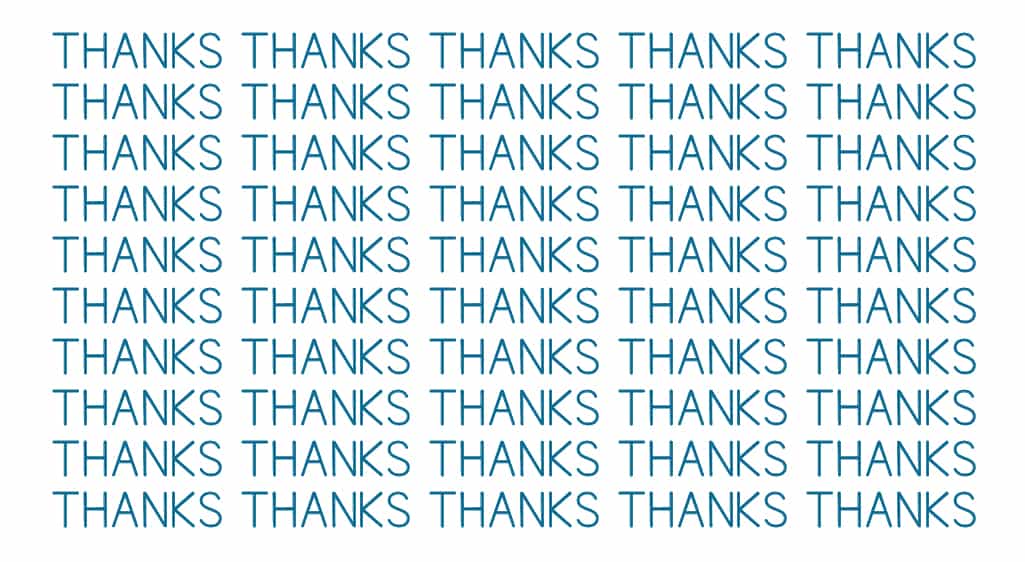
How about this example? Can you figure this one out?
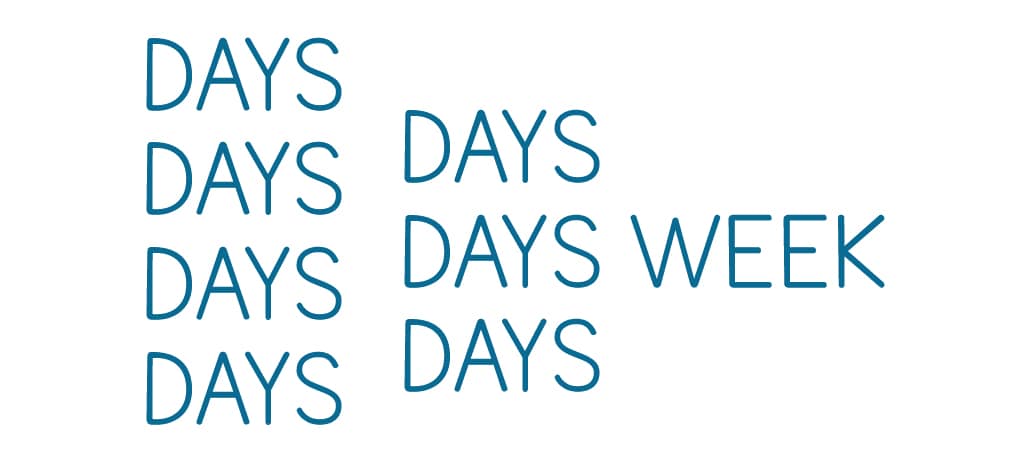
Remember, paying attention to repetition is an important key to becoming a rebus expert!
Answers:
Thanks a lot.
seven days a week
17. Highlighted Clues in Rebus Puzzles for Kids
In a rebus puzzle, sometimes clues are highlighted to take hold of your attention.
This could be indicated by an arrow, bold text, a circle, or underlining. These hints guide you to key information you need to solve the puzzle.

In this example, an arrow points to the ‘T’ in “The,” highlighting the beginning of the phrase. This clue will lead you to the answer.
Give this next example a try. Notice that the word ‘speed’ is written four times and the first one, the one at the top, is circled.
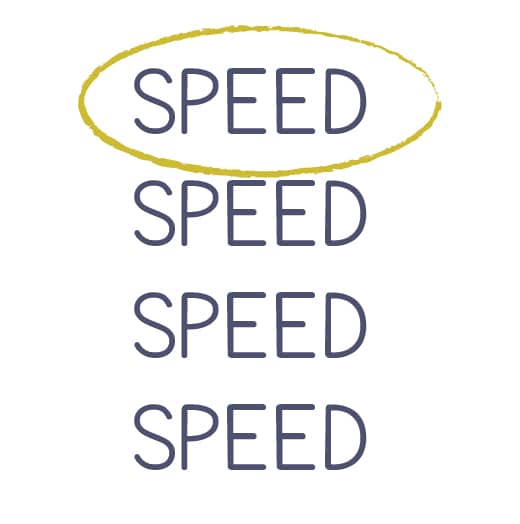
These examples demonstrate how paying attention to specific details within a rebus can lead to puzzles solving success.
Answers:
The beginning of the end.
top speed
18. Size and Style Matter
The size of words or symbols in a riddle can hold the key to unlocking their meaning, and so can the style they are written.
Whether they’re large, small, skinny, wide, tall, or thick, size variations add an intriguing dimension to the puzzle-solving adventure.
For instance, take a look at this rebus puzzle where the word “DEAL” stands out in a big way. Can you solve this riddle?
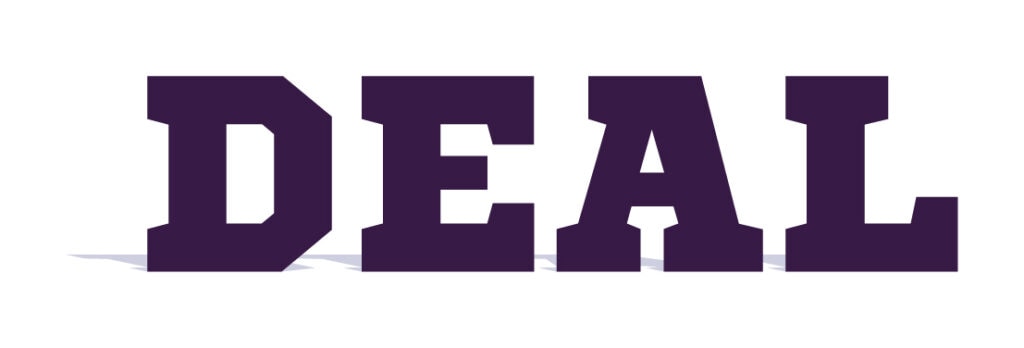
And remember, this works the other way around, too! Here’s an example of something quite tiny.

In these word riddles, the size and style of words act as helpful clues that guide you to the answers. So, pay attention to how words look!
Answers:
a big deal
small talk
19. Hues Can Be Clues
Rebus puzzles often come alive with the use of colour.
When you spot words or symbols in hues other than standard black ink, it’s a clue that colour plays a role in the answer.
Here’s a simple example to illustrate the point. When you see the word ‘thumb’ written in green, you have more than enough information to solve the riddle.

Here’s another example that plays with colour.

Look closely at the colours used in rebus puzzles because they can help you find the answer!
Answers:
green thumb
tickled pink
😍 Loving this Guide?
You can elevate the fun with our kid-friendly Printable Rebus Puzzle Guide & Cards! Perfect for boosting language skills and sparking curiosity. Add excitement to your learning journey today!
The Appeal of Rebus Puzzles for Kids
As a teacher who loves to use rebus puzzles with elementary students, I can tell you firsthand that they are immensely appealing to young curious minds.
I believe this is because rebus puzzles for kids:
Provide Visual Engagement
Kids are naturally drawn to visuals, and rebus puzzles offer a multi-sensory experience, making them interactive and engaging.
Being so visually stimulating, rebus puzzles spark kids’ imagination and encourage them to think creatively, fostering a love for solving puzzles and mental challenges from an early age.
Offer a Sense of Achievement
Solving rebus puzzles provides a sense of accomplishment, boosting children’s self-esteem and confidence. As kids analyze and interpret the images, they feel a sense of achievement and curiosity, encouraging them to solve more puzzles.

With every puzzle they solve, students gain valuable experience and a deeper understanding of what to look for, setting them on a path of continuous learning and growth.
Make Them Think
Rebus puzzles challenge kids to think outside the box, developing their problem-solving and logical reasoning skills. By observing the visual clues, kids learn to think analytically, make connections, and deduce the intended words or phrases.
This process not only enhances their cognitive abilities but also nurtures their ability to approach complex problems with creativity and patience. Rebus puzzles thus become a valuable educational tool that cultivates essential skills while providing hours of fun and mental stimulation for young minds.
Boost Their Brainpower
These puzzles enhance children’s cognitive abilities, such as attention to detail, memory, and pattern recognition. The process of decoding the images and translating them into meaningful words reinforces cognitive connections, supporting brain development.
The best part – this cognitive growth extends beyond puzzle-solving, benefiting various aspects of a child’s academic and intellectual growth.
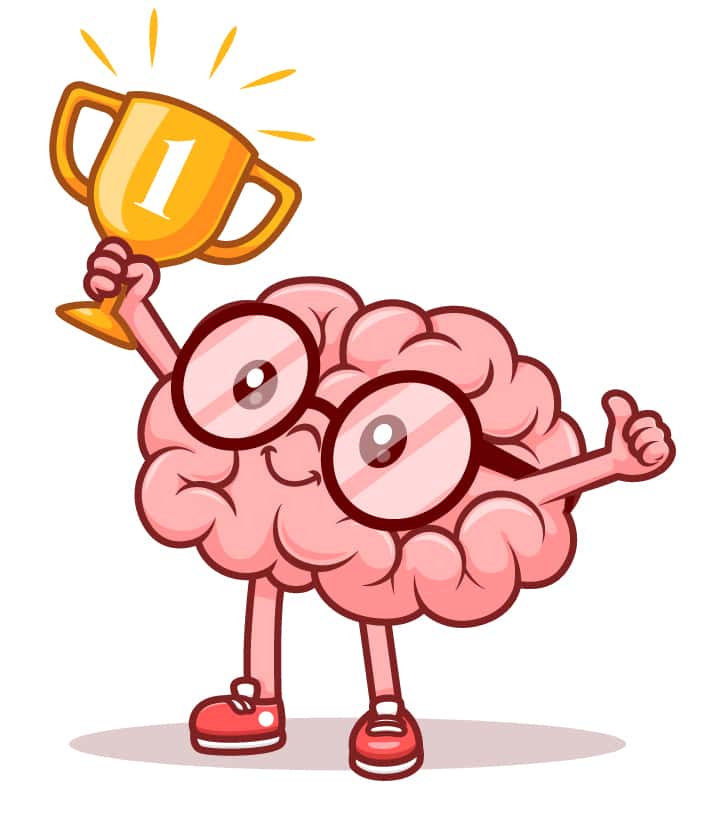
Are Fun!
Sure, rebus puzzles encourage kids to think about language and word associations, which in turn improves their vocabulary and language comprehension – but let’s be honest, rebus puzzles are super fun to solve!
Their element of playfulness and intrigue makes learning an enjoyable adventure, proving that education and entertainment can go hand in hand, fostering a lifelong love for learning and problem-solving in children.
Benefits of Rebus Puzzles for Kids
These delightful brain teasers provide a captivating and educational experience for young minds.
Over the years as a Montessori elementary teacher, I have observed several benefits when using rebus puzzles with my students, including:
Enhanced Vocabulary
Rebus puzzles introduce kids to new words and phrases, expanding their vocabulary in a playful manner. As they decode each puzzle, they come across words and sayings they may not have otherwise encountered in regular reading.
This exposure to unique and sometimes quirky language expressions adds an element of surprise and curiosity to their learning experience, making it even more engaging and memorable.
Problem-Solving Skills
Kids learn to solve problems logically, breaking down complex puzzles into simpler components.
This process of problem-solving encourages kids to think step by step and analyze the information provided by the images.
Rebus puzzles also teach the valuable lesson that it’s perfectly acceptable to make mistakes and keep trying. This process of trial and error instills resilience in young minds, reinforcing the idea that setbacks are part of the problem-solving journey.
Attention to Detail
Rebus puzzles are like detective training for kids’ eyes. They become experts at spotting even the tiniest details in pictures and words. This sharpens their focus not only on puzzles but also on school and everyday life.
Pattern Recognition
Recognizing patterns within the puzzles helps improve children’s cognitive abilities. As they identify recurring elements or combinations, they become better at recognizing patterns in different contexts. For example, once students grasp that 👁️ often represents the pronoun ‘I’ in these puzzles, they swiftly recognize this symbol, fostering their confidence in recognizing and interpreting patterns.
Being Open to Learning
Engage students’ minds with the captivating world of rebus puzzles, infusing learning with an element of playfulness and creativity. By integrating these interactive and enjoyable puzzles into the classroom, educators can foster a dynamic learning environment that promotes active participation and retention of information.
Children thrive when learning becomes an enjoyable adventure, sparking curiosity and igniting their passion for discovery.
With numerous incredible benefits, rebus puzzles are indeed a valuable addition to any elementary teacher’s toolkit.
The Many Uses of Rebus Puzzles for Kids
Looking for different ways to use rebus puzzles with your elementary-aged students? Here’s how you can add picture riddles to your learning routine:
Following Language Lessons
After introducing new language concepts, such as idioms, puns, synonyms, creative writing, parts of speech, or even reading activities, use rebus puzzles as fun follow-up activities. They are a great engaging vocabulary development activity because they allow students to apply what they’ve learned in a fun and interactive way, reinforcing their understanding of the material.
Icebreakers and Teamwork
Using rebus puzzles as icebreakers with elementary students is a fantastic way to create a positive and engaging learning environment.
By dividing students into small groups, these puzzles promote teamwork and communication as they work together to decipher the clues. You can also turn it into a friendly competition, setting time limits and awarding points for correct answers, adding an element of excitement to the activity.
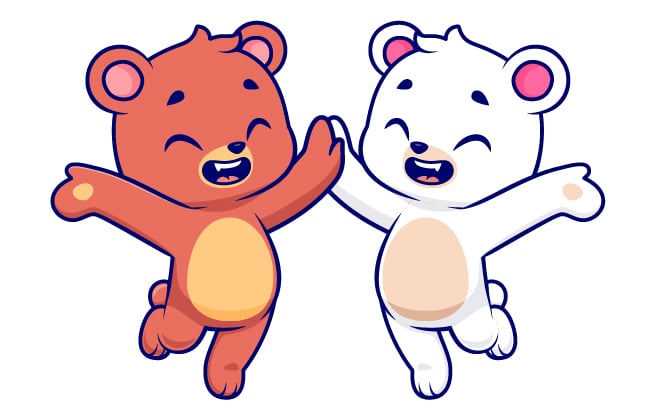
Rebus Puzzles for Kids as a Reward
When students know that they have a chance to solve these engaging puzzles as a reward, it adds an element of excitement to the learning process.
It not only encourages good behaviour but also serves as a positive reinforcement for completing assignments on time and with quality. Students are more likely to stay engaged in their tasks, knowing that a fun challenge awaits them as a bonus.
For Early Finishers
Celebrate students who finish their work early with some brain-boosting fun through rebus puzzles. These visual challenges encourage creative thinking and problem-solving, making them an engaging and educational pastime for eager learners.
With Family or Friends
Rebus puzzles can be a fantastic way to bring families and friends together for some quality bonding time.
Whether it’s a cozy evening at home or a gathering with friends, these puzzles offer an enjoyable and interactive activity that everyone can participate in. These shared experiences not only create lasting memories but also strengthen relationships and connections among family members and friends.
🙌🏼 Fun Fact:
Rebus puzzles go by various names, including frame games, word puzzles, brainteasers, and picture riddles.
DIY Rebus Puzzles
Let kids create their very own rebus puzzles for their friends or classmates, fostering creativity and imagination. They can use symbols, drawings, and letters to craft personalized puzzles.
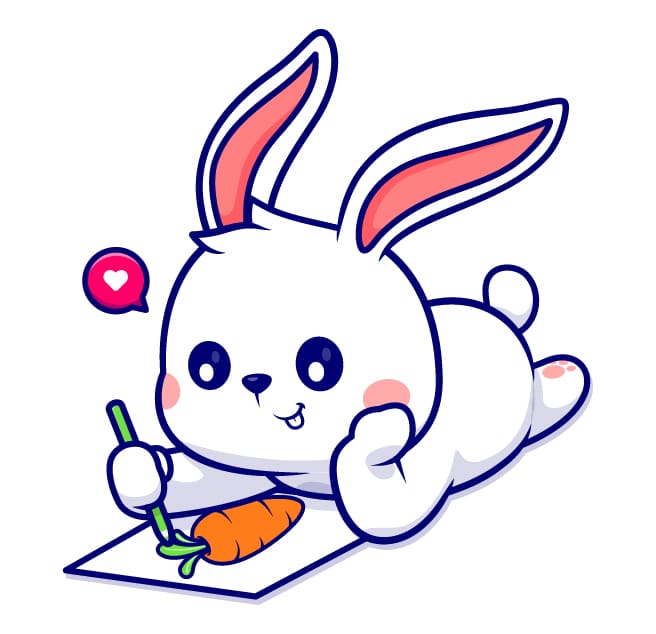
As Part of a History Lesson
Rebus puzzles can be integrated into history lessons as a fun and engaging way to spark students’ curiosity. By crafting rebus puzzles that depict key historical moments or figures, teachers can encourage students to decipher these visual codes. It not only reinforces their understanding of history but also promotes a deeper connection to the subject, making learning history an enjoyable adventure.
Rebus puzzles have long proven to be an engaging and interactive tool for enhancing vocabulary skills, and their history is equally fascinating.
The History of Rebus Puzzles
Rebus puzzles, with their fascinating blend of images, symbols, and letters, have a rich history that dates back to ancient civilizations.
Let’s take a trip back in time to explore the beginnings of these captivating riddles.
Ancient Origins of Pictograms
Rebus puzzles find their roots in the earliest forms of human communication. In ancient civilizations, people used pictograms to convey messages and ideas. Egyptian hieroglyphics, a well-known example, employed images to represent both sounds and objects, creating a basic form of rebus-like writing.

Medieval Rebus Writing
During the medieval period, rebus puzzles began to take shape as more complex wordplay. They appeared in manuscripts and heraldry, combining images with phonetic representations to convey hidden messages and meanings. As the use of rebuses expanded, they became a popular literary device, adding a touch of mystery and intrigue to art and literature.
Rebus as a Literary Device
During the Renaissance, a time of profound creativity and cultural rebirth, the use of rebus puzzles thrived. These clever combinations of words and images became a playful form of expression, often used in art, literature, and personal correspondence. Renaissance thinkers and artists embraced the visual and verbal richness of rebus puzzles to convey hidden meanings, adding an extra layer of intrigue to their work.
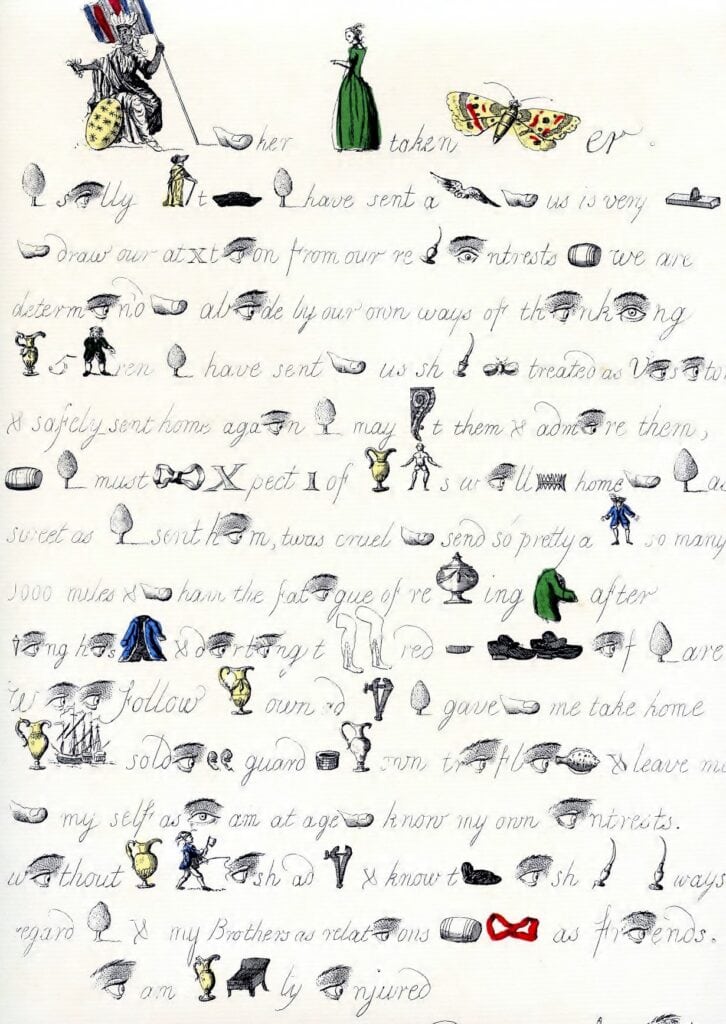
Rebus in Popular Culture
As literacy rates increased, rebus puzzles found their way into popular culture. In the 19th and 20th centuries, rebus books and magazines became a popular form of entertainment, challenging readers with creative and interactive puzzles. Rebus stories also emerged as an effective tool to aid young readers in developing language skills, bridging the gap between pictures and words.
Rebus in Modern Times
With the advent of the digital age, rebus puzzles have evolved yet again. The Internet and digital media brought forth a new era of interactive rebus challenges, allowing enthusiasts from around the world to enjoy and share these delightful brainteasers. In addition, rebus puzzles found a place in advertising, becoming creative marketing strategies that engaged consumers and conveyed messages in clever and memorable ways.
Text Messaging
Emojis are essentially a modern adaptation of the visual clues found in traditional rebus puzzles. When you send a heart emoji via text to convey your love or use a smiley face to express happiness, you’re essentially crafting a mini rebus puzzle. These emojis serve as visual symbols that represent specific words or emotions, just like the images in classic Rebus puzzles.

The history of rebus puzzles showcases their timeless allure as a playful and intellectually stimulating form of wordplay. From ancient pictograms to modern digital challenges, rebuses have stood the test of time, continuing to captivate minds and provide a delightful blend of fun and learning.
💡 This valuable insight into the world of rebuses can be a wonderful addition to the Montessori Five Great Lessons, especially the 4th lesson, the Story of Writing, enhancing the educational journey with engaging linguistic adventures.
Rebus Puzzles are Fun and Beneficial for Adults, Too!
Rebus puzzles aren’t just for kids – they’re enjoyable and beneficial for adults too! These brain teasers are a great way for adults to have fun while keeping their minds sharp.
Solving rebus puzzles requires creative problem-solving skills, lateral thinking, and the ability to decode visual cues. Engaging with such puzzles not only provides a mental workout but also stimulates various cognitive functions.
It encourages adults to think outside the box, making connections between seemingly unrelated symbols, words, and concepts.
Rebus puzzles are a fantastic choice for seniors as well, helping them keep their minds agile and engaged in a fun way. This mental exercise is vital for maintaining cognitive health and agility, a factor that contributes to keeping the brain youthful and active throughout life.
Can you solve this tricky rebus puzzle for adults? It represents a phrase commonly used when choosing all the answers to a multiple-choice question.
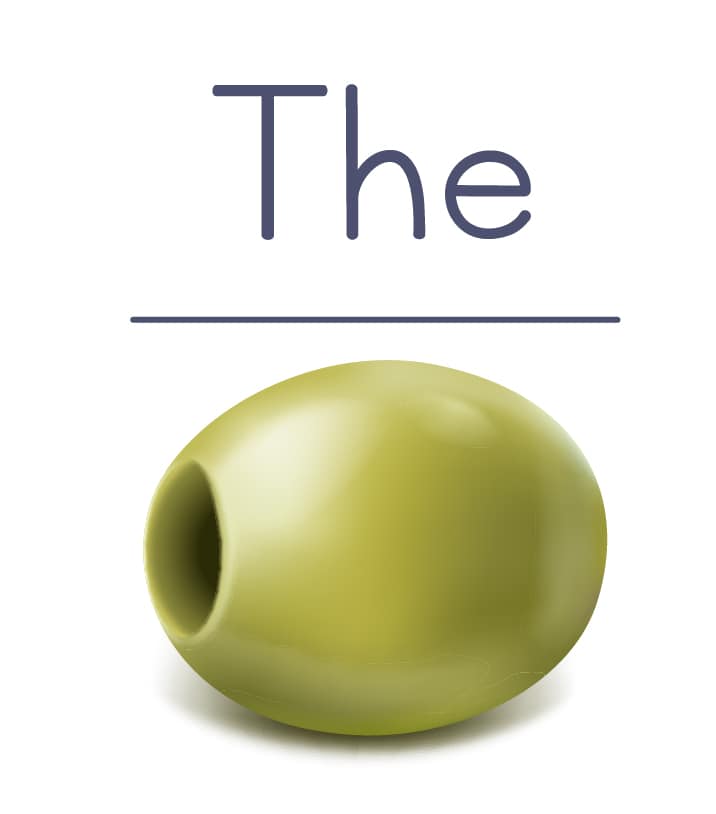
What about this rebus puzzle below? This term often describes a situation or environment where personal space is limited.
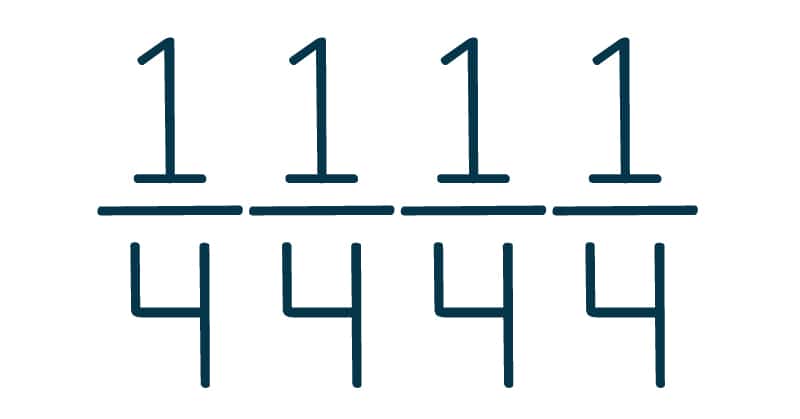
Whether you seek entertainment or a stimulating challenge, rebus puzzles are the perfect way to unwind and exercise your brain in a playful and enjoyable way!
Answers:
all of the above
close quarters
The Wrap-Up: Rebus Puzzles for Kids
This comprehensive guide all about rebus puzzles for kids is packed with helpful strategies, examples, and tips to help elementary learners become experts at solving these puzzles. Rebus puzzles are not just fun; they also help kids think better, learn new words, and use their imagination.
Whether you begin exploring rebus puzzles with the examples provided here, delve into our blog 9 Unique Rebus Puzzles with Answers for Kids, or start with these 8 Easy Rebus Puzzles with Answers you’ll discover how these puzzles can enhance kids’ thinking skills and make learning more exciting!
🚀 Keep boredom at bay and make learning a blast with our Printable Rebus Puzzle Guide and Cards!
Unleash the power of disguised learning that’s so fun, that your kids won’t even realize they’re soaking up knowledge.
Get yours now to keep the kids busy learning and having a blast! Click here!
🧐 Keep your kids busy learning with the fun and educational activities outlined in these blogs:
11 Ways to Use Our Roll A Story Dice Game
31 Fun Summer Reading Activities Elementary Students Will Love (+ Free Download!)
The Best Neighborhood Walk Scavenger Hunt and 13 Different Ways to Use It
8 Easy Rebus Puzzles with Answers
27 Educational YouTube Channels to Prevent Summer Learning Loss

